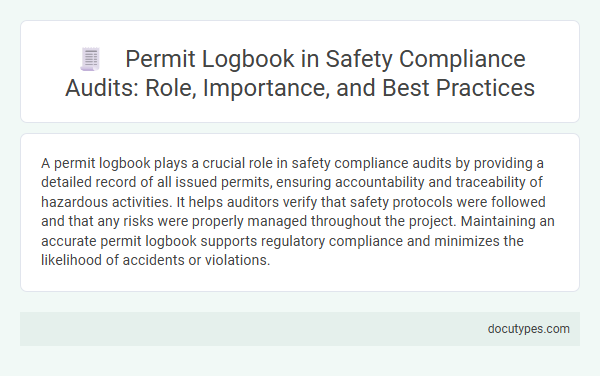A permit logbook plays a crucial role in safety compliance audits by providing a detailed record of all issued permits, ensuring accountability and traceability of hazardous activities. It helps auditors verify that safety protocols were followed and that any risks were properly managed throughout the project. Maintaining an accurate permit logbook supports regulatory compliance and minimizes the likelihood of accidents or violations.
Introduction to Permit Logbooks in Safety Compliance
Permit logbooks serve as essential records in maintaining safety compliance during audits. They document all issued permits, ensuring accountability and traceability throughout safety processes.
- Centralized Record Keeping - Permit logbooks provide a single source for tracking all safety permits issued on-site.
- Audit Readiness - These logbooks facilitate quick retrieval of permit details during safety compliance audits.
- Regulatory Compliance - Maintaining a permit logbook helps demonstrate adherence to safety regulations and standards.
Defining the Permit Logbook: Purpose and Scope
A permit logbook serves as a critical tool in safety compliance audits by systematically recording all issued permits related to hazardous work. Its purpose is to ensure accurate documentation, tracking, and verification of permits to maintain workplace safety standards and regulatory compliance. Your use of a well-maintained permit logbook helps auditors confirm that safety protocols are consistently followed and risks are properly managed.
Regulatory Requirements for Permit Logbooks
| Aspect | Details |
|---|---|
| Definition | A permit logbook is a documented record of all issued permits related to safety and operational activities within a facility or worksite. |
| Purpose in Safety Compliance Audits | Ensures traceability and accountability of all permits granted, confirming adherence to safety rules and procedures during inspections. |
| Regulatory Requirements | Many regulatory bodies mandate maintaining an accurate and up-to-date permit logbook as part of legal safety compliance frameworks. It must contain detailed information such as permit type, issuance date, authorized personnel, duration, and scope of work. |
| Audit Importance | During audits, regulators review the permit logbook to verify that all necessary safety permits were issued before hazardous tasks commenced. Missing or incomplete logbook entries can lead to compliance violations and penalties. |
| Best Practices | Your permit logbook should be systematically maintained, regularly updated, and readily accessible to auditors. Digital logbooks equipped with timestamp and authorization records improve accuracy and ease of review. |
Role of Permit Logbooks in Safety Compliance Audits
Permit logbooks serve as critical tools for tracking safety procedures and ensuring regulatory compliance during audits. They provide documented evidence of authorized activities and safety measures implemented on-site.
- Verification of Compliance - Permit logbooks offer a clear record of compliance with safety regulations, enabling auditors to verify that all safety permits were properly issued and followed.
- Accountability and Traceability - They establish accountability by logging who authorized and executed each permit, making it easier to trace actions and responsibilities during audits.
- Risk Management Documentation - Permit logbooks document risk assessments and safety precautions taken, supporting your efforts to maintain a safe working environment and meet audit requirements.
Key Components of an Effective Permit Logbook
What is the role of a permit logbook in safety compliance audits? A permit logbook serves as a critical record for tracking all issued permits, ensuring transparency and accountability. It helps auditors verify that safety protocols are strictly followed during hazardous operations.
What are the key components of an effective permit logbook? An effective permit logbook includes detailed permit descriptions, date and time stamps, and the names of authorized personnel. It also records hazard assessments, safety measures implemented, and approval signatures to maintain comprehensive documentation.
Ensuring Data Integrity and Accuracy in Permit Records
A permit logbook plays a crucial role in safety compliance audits by maintaining accurate and reliable records of issued permits. It ensures that all permit data is consistently documented to support audit verification processes.
- Ensures Data Integrity - Maintains a tamper-proof record of permit issuance and completion to prevent discrepancies.
- Enhances Accuracy - Captures detailed information about each permit, including dates, responsible personnel, and safety measures.
- Supports Regulatory Compliance - Provides clear, organized documentation required to meet regulatory standards during audits.
Your safety compliance audits benefit from the structured and accurate permit records maintained in the logbook, facilitating efficient and transparent review.
Common Challenges in Permit Logbook Management
A permit logbook serves as a critical tool in safety compliance audits by systematically recording all issued permits, ensuring traceability and accountability. It enables auditors to verify that safety procedures were followed and permits were properly managed during high-risk operations.
Common challenges in permit logbook management include incomplete or inaccurate entries, making it difficult to track permit status and compliance history. Physical logbooks are prone to damage, loss, or illegibility, which compromises data integrity. Ensuring timely updates and consistent documentation requires ongoing training and strict adherence to protocol.
Best Practices for Maintaining Permit Logbooks
A permit logbook plays a crucial role in safety compliance audits by providing a detailed record of all issued permits, ensuring traceability and accountability. Best practices for maintaining permit logbooks include accurately documenting permit details, regularly updating entries, and securely storing the logbook to prevent unauthorized access. Consistent maintenance of the permit logbook supports audit readiness and strengthens overall workplace safety management.
Leveraging Digital Solutions for Permit Logbook Efficiency
A permit logbook serves as a critical record-keeping tool during safety compliance audits, documenting all issued permits and their associated details. It ensures accountability and traceability of safety procedures, helping organizations meet regulatory requirements.
Leveraging digital solutions for permit logbooks enhances data accuracy, accessibility, and real-time updates. Digital systems streamline audit preparation, reduce human error, and improve overall permit management efficiency in industrial and construction environments.
What Is the Role of a Permit Logbook in Safety Compliance Audits? Infographic

